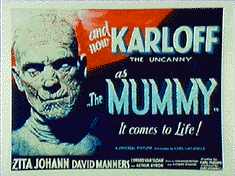 |
| Mummies, and the process of making them, have fascinated students and
scholars for centuries. Here's how they made
them . . .
|
|
Why did the Egyptians make mummies? The ancient Egyptians observed that bodies buried under the desert were dried out and preserved. Based on this observation, they believed that a person's spirit, or soul, lived on after their death. |
 |
It was important that the spirit recognize its body in the afterlife so that it would have somewhere to live. Preserving the body through mummification was the best solution, but a statue of the deceased could provide a back-up resting place. The spirit could eat, play, and enjoy all the things it did during life. Therefore, the Egyptian burial had to provide everything for life in the tomb!
|
| Journey to eternity . . . Once the body
was mummified and encased in a coffin
(like below), it was placed in a
tomb. There were several types
of tombs built over the centuries in ancient Egypt:
|
 |
|
|
|
Inside, the tomb walls were decorated with scenes from life -- sports, banquets, and everyday activities. These scenes would provide for the deceased in the afterlife. Objects were also buried in the tomb to serve the dead person in the afterlife: |
|
|
| Ready to play the Read the CT Scan Game? |
 |
 |
 |
 |
 |
 |
© Michael C. Carlos Museum of Emory University,
Memorial Art Gallery of the University of Rochester and Dallas Museum of Art
For more information please contact odyssey@emory.edu.
Last Update: